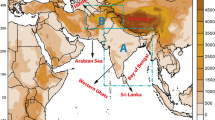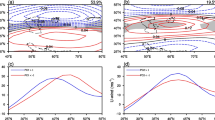Abstract
The Great Plains Low-Level Jet (GPLLJ) is an important driver of precipitation and severe weather outbreaks over the US Great Plains and undergoes large interannual variability. Therefore, to reliably make predictions and projections of Great Plains precipitation, it is essential for the observed influence of ENSO on the GPLLJ to be understood and simulated accurately by global climate models. This study uses four reanalyzes and an ensemble of 42 historical simulations from phase 5 of the Coupled Model Intercomparison Project (CMIP5) to investigate the accuracy of the simulated ENSO–GPLLJ teleconnection. From observations, winter ENSO has a significant negative correlation with the GPLLJ in the following spring and a significant positive correlation with the GPLLJ in the following summer. Here, it is shown that the influence of ENSO is on the frequency, not intensity, of GPLLJ events in the spring, while both the frequency and intensity of GPLLJ events are affected in the summer. However, although the majority of CMIP5 historical simulations exhibit the observed significant negative ENSO–GPLLJ correlations in the spring, nearly all of them fail to simulate the significant positive correlation in the summer. The ability of the models to simulate the ENSO–GPLLJ relationship is attributed to the strength of simulated ENSO events and the associated effects on geopotential heights and atmospheric circulation. These results have implications for the predictability of weather and climate in the Great Plains and suggest that the variability of the GPLLJ will not be reliably captured in future climate simulations if the magnitude of ENSO events and their impacts are not well represented.
















Similar content being viewed by others
References
Adachi Y et al (2013) Basic performance of a new earth system model of the Meteorological Research Institute (MRI-ESM1). Pap Meteorol Geophys 64:1–19. doi:10.2467/mripapers.64.1
Arora VK et al (2011) Carbon emission limits required to satisfy future representative concentration pathways of greenhouse gases. Geophys Res Lett 38:L05805. doi:10.1029/2010GL046270
Baek H-J et al (2013) Climate change in the 21st century simulated by HadGEM2-AO under representative concentration pathways. Asia-Pac J Atmos Sci 49:603–618. doi:10.1007/s13143-013-0053-7
Bao Q et al (2012) The flexible global ocean–atmosphere–land system model, spectral version 2: FGOALS-s2. Adv Atmos Sci 30:561–576. doi:10.1007/s00376-012-2113-9
Barandiaran D, Wang SY, Hilburn K (2013) Observed trends in the Great Plains low-level jet and associated precipitation changes in relation to recent droughts. Geophys Res Lett 40:6247–6251. doi:10.1002/2013GL058296
Bellenger H, Guilyardi E, Leloup J, Lengaigne M, Vialard J (2014) ENSO representation in climate models: from CMIP3 to CMIP5. Clim Dyn 42:1999–2018. doi:10.1007/s00382-013-1783-z
Bentsen M et al (2013) The Norwegian Earth System Model, NorESM1-M—part 1: description and basic evaluation of the physical climate. Geosci Model Dev 6:687–720. doi:10.5194/gmd-6-687-2013
Berg LK, Riihimaki LD, Qian Y, Yan H, Huang M (2015) The low-level jet over the southern Great Plains determined from observations and reanalyses and its impact on moisture transport. J Clim 28:6682–6706. doi:10.1175/JCLI-D-14-00719.1
Blackadar AK (1957) Boundary layer wind maxima and their significance for the growth of nocturnal inversions. Bull Am Meteorol Soc 38:283–290
Collins M, Tett SFB, Cooper C (2001) The internal climate variability of HadCM3, a version of the Hadley centre coupled model without flux adjustments. Clim Dyn 17:61–81. doi:10.1007/s003820000094
Compo GP et al (2011) The twentieth century reanalysis project. Q J R Meteorol Soc 137(654):1–28. doi:10.1002/qj.776
Cook KH, Vizy EK (2010) Hydrodynamics of the Caribbean low-level jet and its relationship to precipitation. J Clim 23:1477–1494. doi:10.1175/2009JCLI3210.1
Cook KH, Vizy EK, Launer ZS, Patricola CM (2008) Springtime intensification of the Great Plains low-level jet and Midwest precipitation in GCM simulations of the twenty-first century. J Clim 21:6321–6340. doi:10.1175/2008JCLI2355.1
Delworth TL et al (2006) GFDL’s CM2 global coupled climate models. Part I: formulation and simulation characteristics. J Clim 19:643–674. doi:10.1175/JCLI3629.1
Donner LJ et al (2011) The dynamical core, physical parameterizations, and basic simulation characteristics of the atmospheric component AM3 of the GFDL global coupled model CM3. J Clim 24:3484–3519, doi:10.1175/2011JCLI3955.1
Dufresne J-L, Coauthors (2013) Climate change projections using the IPSL-CM5 earth system model: from CMIP3 to CMIP5. Clim Dyn 40:2123–2165. doi:10.1007/s00382-012-1636-1
Eichler T, Higgins W (2006) Climatology and ENSO-related variability of North American extratropical cyclone activity. J Clim 19:2076–2093. doi:10.1175/JCLI3725.1
Gent PR et al (2011) The community climate system model version 4. J Clim 24:4973–4991. doi:10.1175/2011JCLI4083.1
Harding KJ, Snyder PK (2015) The relationship between the Pacific–North American teleconnection pattern, the Great Plains low-level jet, and North Central US heavy rainfall events. J Clim 28:6729–6742. doi:10.1175/JCLI-D-14-00657.1
Higgins RW, Yao Y, Yarosh ES, Janowiak JE, Mo KC (1997) Influence of the Great Plains low-level jet on summertime precipitation and moisture transport over the central United States. J Clim 10:481–507. doi:10.1175/1520-0442(1997)010<0481:IOTGPL>2.0.CO;2
Holton JR (1967) The diurnal boundary layer wind oscillation above sloping terrain. Tellus 19:199–205
Hurwitz MM, Calvo N, Garfinkel CI, Butler AH, Ineson S, Cagnazzo C, Manzini E, Peña-Ortiz C (2014) Extra-tropical atmospheric response to ENSO in the CMIP5 models. Clim Dyn 43:3367–3376. doi:10.1007/s00382-014-2110-z
Jiang X, Lau N-C, Held IM, Ploshay JJ (2007) Mechanisms of the Great Plains low-level jet as simulated in an AGCM. J Atmos Sci 64:532–547. doi:10.1175/JAS3847.1
Jones CD et al (2011) The HadGEM2-ES implementation of CMIP5 centennial simulations. Geosci Model Dev 4:543–570. doi:10.5194/gmd-4-543-2011
Kim ST, Yu J-Y (2012) The two types of ENSO in CMIP5 models. Geophys Res Lett 39:L11704. doi:10.1029/2012GL052006
Kim D, Sobel AH, Del Genio AD, Chen Y, Camargo SJ, Yao M-S, Kelley M, Nazarenko L (2012) The tropical subseasonal variability simulated in the NASA GISS general circulation model. J Clim 25:4641–4659. doi:10.1175/JCLI-D-11-00447.1
Krishnamurthy L, Vecchi GA, Msadek R, Wittenberg A, Delworth TL, Zeng F (2015) The seasonality of the Great Plains low-level jet and ENSO relationship. J Clim 28:4525–4544. doi:10.1175/JCLI-D-14-00590.1
Lee SK, Atlas R, Enfield D, Wang C, Liu H (2013) Is there an optimal ENSO pattern that enhances large-scale atmospheric processes conducive to tornado outbreaks in the United States? J Clim 26:1626–1642. doi:10.1175/JCLI-D-12-00128.1
Li L et al (2013) The flexible global ocean–atmosphere–land system model, grid-point version 2: FGOALS-g2. Adv Atmos Sci 30:543–560. doi:10.1007/s00376-012-2140-6
Long MC, Lindsay K, Peacock S, Moore JK, Doney SC (2013) Twentieth-century oceanic carbon uptake and storage in CESM1 (BGC). J Clim 26:6775–6800. doi:10.1175/JCLI-D-12-00184.1
Marsh DR, Mills MJ, Kinnison DE, Lamarque J-F, Calvo N, Polvani LM (2013) Climate change from 1850 to 2005 simulated in CESM1(WACCM). J Clim 26:7372–7391. doi:10.1175/JCLI-D-12-00558.1
Martin ER, Schumacher C (2011) The Caribbean low-level jet and its relationship with precipitation in IPCC AR4 models. J Clim 24:5935–5950. doi:10.1175/JCLI-D-11-00134.1
Meehl GA et al (2013) Climate change projections in CESM1(CAM5) compared to CCSM4. J Clim 26:6287–6308. doi:10.1175/JCLI-D-12-00572.1
Muñoz E, Enfield D (2011) The boreal spring variability of the Intra-Americas low-level jet and its relation with precipitation and tornadoes in the eastern United States. Clim Dyn 36:247–259. doi:10.1007/s00382-009-0688-3
Perez J, Menendez M, Mendez FJ, Losada IJ (2014) Evaluating the performance of CMIP3 and CMIP5 global climate models over the north-east Atlantic region. Clim Dyn 43:2663–2680. doi:10.1007/s00382-014-2078-8
Phipps SJ, Rotstayn LD, Gordon HB, Roberts JL, Hirst AC, Budd WF (2011) The CSIRO Mk3L climate system model version 1.0—part 1: description and evaluation. Geosci Model Dev 4:483–509. doi:10.5194/gmd-4-483-2011
Polade SD, Gershunov A, Cayan DR, Dettinger MD, Pierce DW (2013) Natural climate variability and teleconnections to precipitation over the Pacific–North American region in CMIP3 and CMIP5 models. Geophys Res Lett 40:2296–2301. doi:10.1002/grl.50491
Poli P et al (2016) ERA-20C: an atmospheric reanalysis of the twentieth century. J Clim 29:4083–4097. doi:10.1175/JCLI-D-15-0556.1
Pu B, Dickinson RE (2014) Diurnal spatial variability of Great Plains summer precipitation related to the dynamics of the low-level jet. J Atmos Sci 71:1807–1817. doi:10.1175/JAS-D-13-0243.1
Rayner NA, Parker DE, Horton EB, Folland CK, Alexander LV, Rowell DP, Kent EC, Kaplan A (2003) Global analyses of sea surface temperature, sea ice, and night marine air temperature since the late nineteenth century. J Geophys Res 108(D14):4407. doi:10.1029/2002JD002670
Saha S, Coauthors (2010) The NCEP climate forecast system reanalysis. Bull Am Meteorol Soc 91:1015–1057. doi:10.1175/2010BAMS3001.1
Schubert SM, Suarez J, Pegion PJ, Koster RD, Bacmeister JT (2004) Causes of long-term drought in the U.S. Great Plains. J Clim 17:485–503. doi:10.1175/1520-0442(2004)017<0485:COLDIT>2.0.CO;2
Sheffield J et al (2013) North American climate in CMIP5 experiments. Part I: evaluation of historical simulations of continental and regional climatology. J Clim 26:9209–9245. doi:10.1175/JCLI-D-12-00592.1
Shinker JJ, Bartlein PJ (2009) Visualizing the large-scale patterns of ENSO-related climate anomalies in North America. Earth Interact 13(3):1–50. doi:10.1175/2008EI244.1
Simmons AJ, Poli P, Dee DP, Berrisford P, Hersbach H, Kobayashi S, Peubey C (2014) Estimating low-frequency variability and trends in atmospheric temperature using ERA-Interim. Q J R Meteorol Soc 140(679):329–353. doi:10.1002/qj.2317
Stensrud DJ (1996) Importance of low-level jets to climate: a review. J Clim 9:1698–1711. doi:10.1175/1520-0442(1996)009<1698:IOLLJT>2.0.CO;2
Taylor KE, Stouffer RJ, Meehl GA (2012) An overview of CMIP5 and the experiment design. Bull Am Meteorol Soc 93:485–498. doi:10.1175/BAMS-D-11-00094.1
Voldoire A et al (2013) The CNRM-CM5.1 global climate model: description and basic evaluation. Clim Dyn 40:2091–2121. doi:10.1007/s00382-011-1259-y
Volodin EM, Diansky NA, Gusev AV (2010) Simulating present-day climate with the INMCM4.0 coupled model of the atmospheric and oceanic general circulations. Inv Atmos Ocean Phys 46:414–431. doi:10.1134/S000143381004002X
Watanabe M et al (2010) Improved climate simulation by MIROC5: mean states, variability, and climate sensitivity. J Clim 23:6312–6335. doi:10.1175/2010JCLI3679.1
Weaver SJ, Nigam S (2008) Variability of the Great Plains low-level jet: large-scale circulation context and hydroclimate impacts. J Clim 21:1532–1551. doi:10.1175/2007JCLI1586.1
Weaver SJ, Schubert S, Wang H (2009) Warm season variations in the low-level circulation and precipitation over the central United States in observations, AMIP simulations, and idealized SST experiments. J Clim 22:5401–5420. doi:10.1175/2009JCLI2984.1
Wexler H (1961) A boundary layer interpretation of the low level jet. Tellus 13:368–378
Xin X, Wu T, Zhang J (2012) Introductions to the CMIP5 simulations conducted by the BCC climate system model. Adv Climate Change Res 8:378–382 (in Chinese)
Yukimoto S et al (2012) A new global climate model of the Meteorological Research Institute: MRI-CGCM3—model description and basic performance. J Meteorol Soc Jpn 90A:23–64. doi:10.2151/jmsj.2012-A02
Zanchettin D, Rubino A, Matei D, Bothe O, Jungclaus JH (2013) Multidecadal-to-centennial SST variability in the MPI-ESM simulation ensemble for the last millennium. Clim Dyn 40:1301–1318. doi:10.1007/s00382-012-1361-9
Zhang W, Jin F-F (2012) Improvements in the CMIP5 simulations of ENSO-SSTA meridional width. Geophys Res Lett 39:L23704. doi:10.1029/2012GL053588
Zhang T, Sun D-Z (2014) ENSO asymmetry in CMIP5 models. J Clim 27:4070–4093. doi:10.1175/JCLI-D-13-00454.1
Acknowledgements
The authors thank the anonymous reviewer for thoughtful comments and suggestions that greatly strengthened the manuscript. We acknowledge the World Climate Research Programme’s Working Group on Coupled Modelling, which is responsible for CMIP5, and thank the climate modeling groups for producing and making available their model output. For CMIP5, the US Department of Energy’s Program for Climate Model Diagnosis and Intercomparison provides coordinating support and led development of software infrastructure in partnership with the Global Organization for Earth System Science Portals. Support for the Twentieth Century Reanalysis Project version 2c dataset is provided by the US Department of Energy, Office of Science Biological and Environmental Research (BER), and by the National Oceanic and Atmospheric Administration Climate Program Office. ERA20C and ERA-Interim data is provided courtesy of ECMWF, and CFSR data is carried out by the Environmental Modeling Center (EMC), National Centers for Environmental Prediction (NCEP). We also acknowledge the Met Office Hadley Centre for providing HadISST1 data.
Author information
Authors and Affiliations
Corresponding author
Rights and permissions
About this article
Cite this article
Danco, J.F., Martin, E.R. Understanding the influence of ENSO on the Great Plains low-level jet in CMIP5 models. Clim Dyn 51, 1537–1558 (2018). https://doi.org/10.1007/s00382-017-3970-9
Received:
Accepted:
Published:
Issue Date:
DOI: https://doi.org/10.1007/s00382-017-3970-9




